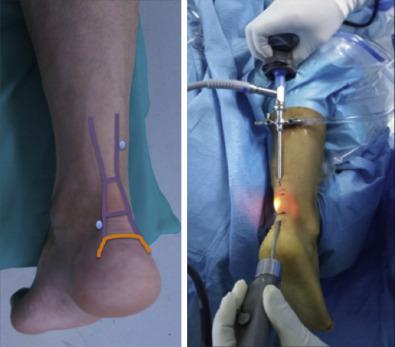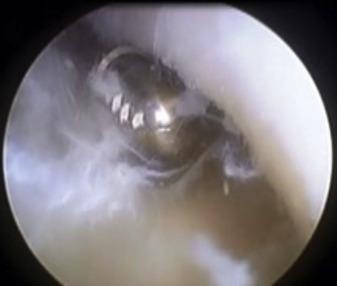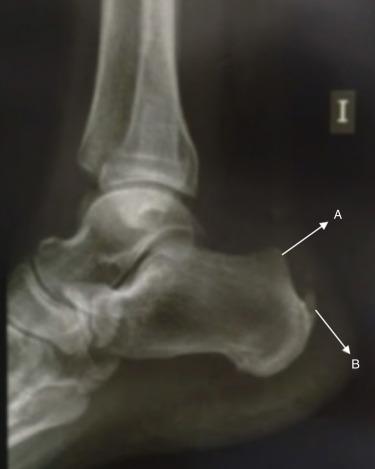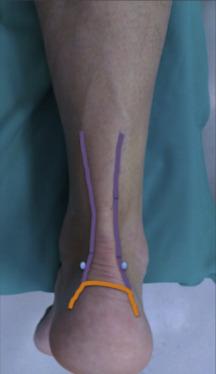Physical Address
304 North Cardinal St.
Dorchester Center, MA 02124
In the last decade, minimal invasive management of multiple foot and ankle pathologies has been proposed, seeking to reduce the postoperative complications that occur in patients classically treated with open surgical management. Arthroscopy and endoscopy has emerged as a powerful minimally invasive tool for intra- and extra-articular pathologies in foot and ankle. As a diagnostic tool, it has been utilized to evaluate articular osteochondral lesions, impingement lesions, syndesmotic instability, and lesser metatarsophalangeal instability, among others. In fracture cases, arthroscopic assistance has been reported to be very useful too, as in pilon, tillaux, talus, and calcaneus fractures, to mention some. For tendinous pathology, increasing indications for diagnostic and treatment alternatives have been reported for the Achilles tendon, posterior tibial, and peroneal tendon, among others. In this review, we will summarize arthroscopic or endoscopic alternatives for foot and ankle pathologies excluding the ankle, subtalar, and metatarsophalangeal joints.
Achilles endoscopic surgery is a minimally invasive option that has been described to manage different pathologies related to the Achilles tendon, including non-insertional Achilles tendinopathy, Haglund’s deformity, equinus contracture, and even Achilles ruptures.
Tendoscopic surgery minimizes some of the risks present in some open procedures by reducing the complications associated with open surgery, such as scarring, perioperative pain, and wound complications, and it may also provide a faster recovery.
The Achilles tendon, or calcaneal tendon, is the thickest and strongest tendon in the human body. It measures approximately 12 to 15 cm in length and is formed by the junction of the aponeurosis of the gastrocnemius (attaches on the distal femur, has two muscle heads, one medial and other lateral, crosses the knee, ankle, and subtalar joints) and soleus muscle (originates posteriorly off the proximal tibia and fibula, and crosses the ankle and subtalar joints). Structurally, the Achilles tendon is formed by fascicles separated by endotenon. Each fascicle is composed of a mature type of fibroblasts denominated tenocytes; these are located in a matrix made of glycoproteins, mucopolysaccharides, elastin, and collagen.
Throughout the tendon trajectory, there is a lateral 90-degree twist, finally inserting itself between 13 and 30 mm distal to the superior portion of the posterior tuberosity of the calcaneus. The previous twist explains the fact that the fibers provided by the gastrocnemius muscle insert at the lateral aspect of the posterior process of the calcaneus and the fibers of the soleus muscle insert at the medial aspect. Some of the insertional fibers are in continuity with the plantar aponeurosis.
The Achilles tendon does not have a sheath, is surrounded by a paratenon that is divided into an outer parietal and inner visceral layer, with a mesotenon layer in the space between both, to provide the blood supply. At the Achilles insertion, the blood supply is limited and is provided by periosteal and osseous vessels. For this reason, it is believed that degenerative changes are often seen in this area and may explain prolonged recovery times for tendinopathic tendons.
Just before its insertion on the calcaneus between the ventral side of the distal part of the Achilles tendon and the calcaneus, the retrocalcaneal bursa is found, which can be inflamed and produce pain. This chronic inflammation can occasionally be detected on plain films because it can disturb Kager’s triangle.
In the gait cycle, the Achilles tendon is placed in maximum tension during the late-stance phase. The gastrocnemius limits the degree of ankle’s dorsiflexion while the knee is in extension, whereas the triceps limits dorsiflexion with the knee in flexion. The late-stance phase dorsiflexion beyond 10 degree of dorsiflexion is dependent on the flexibility of the gastrocnemius muscle.
The soleus and gastrocnemius muscles account for almost 90% of energy in plantarflexion, and the Achilles tendon supports the body weight 12.5 times during running activities.
Chronic achilles tendinopathy has a high prevalence in older athletes. Most of the injuries are caused by overuse during running activities (33%). Clement and colleagues theorized that the injuries are caused by microtrauma produced by fatigued muscles, eccentric loading, or excess tendon loading.
In 1999, Alfredson and colleagues found there were no significant differences in the mean concentrations of prostaglandin E2 between tendons with the diagnosis of “tendinosis” and normal tendons. For this reason, the term “tendinitis” is an inaccurate diagnosis, because the inflammatory reaction rarely is found in the tendon. Instead, degenerative changes have been found as intraoperative findings in patients with overuse injuries, such as calcifications; fibrocartilaginous metaplasia; and fatty, hyaline, and myxoid degeneration. Chronic Achilles tendinopathy can be divided into non-insertional, which can present as a local degeneration of the tendon combined with paratendinopathy, or insertional where tendinopathic changes are found at the insertion, including the retrocalcaneal bursa and the posterior process of the calcaneus.
Non-insertional pathology of the Achilles tendon is frequently found in athletes and runners, who present clinically with painful swelling 4 to 6 cm proximal to the insertion in the calcaneus. It can be divided in three different entities: tendinopathy, paratendinopathy, and a combination of both.
Overuse is commonly associated with this condition, but other factors have been described, such as poor training technique, improper training surface, strength imbalance, compression and friction of the tendon, shoe-related factors, rheumatoid arthritis, and endocrine disorders.
The Achilles tendon is easily palpable even in obese patients, and local tenderness and swelling should be assessed. If the focal tenderness or swelling moves up and down with passive dorsiflexion and plantarflexion, it suggests that the patient suffers from a tendinopathy. This condition can present three different patterns: local degeneration of the tendon but mechanically intact, diffuse thickening of the tendon, or insufficiency of the tendon with a rupture. In paratendinopathy, the swelling does not move and its pathology is exclusively in the paratenon, clinically and also on magnetic resonance imaging (MRI). Often, pain is more severe on the medial side of the achilles. Some investigators have theorized that the degeneration of the soleus tendon and a relatively fixed plantaris tendon is a possible explanation for this medial pain. Medially, the soleus and plantaris tendons are separated by the paratenon and with the simultaneous movement of the knee and ankle both tendons are pulled at the same level and may generate pain.
Imaging in Achilles tendinopathy demonstrates intrasubstance or intrinsic inflammatory changes of the tendon, with MRI findings including fusiform thickening and linear or diffuse low to intermediate signal intensity on T2-weighted or STIR images. On the sagittal MRI view, an anterior convexity or a focal enlargement of the Achilles tendon can be observed. When paratendinopathy is present, where the inflammation is seen in the paratenon, adhesion can be found between the paratenon and the Achilles tendon.
Some other diagnoses should be ruled out when evaluating Achilles tendinopathic patients, like tendinitis of the tibialis posterior or flexor hallucis longus tendon; peroneal tendinopathy; posterior subtalar arthritis; ankle arthritis; tarsal tunnel syndrome; posterior ankle impingement; seronegative arthritis; and systemic diseases, including seropositive arthritis (Rheumatoid arthritis, lupus).
Conservative management (nonsteroidal antiinflammatory drugs, activity modifications, shoe modifications, insoles, immobilization, and eccentric stretching) is the first-line of treatment. The use of steroid injections in any presentation is controversial, and injections around or inside the Achilles tendon can promote degeneration and increase the risk for a subsequent rupture of the tendon. In refractory cases, shock wave therapy could be considered as second-line intervention because of its similar effectiveness to tendon eccentric strengthening. In patients with combined paratendinopathy and tendinopathy, it can be difficult to determine which pathology needs to be treated, because the role of the focal tendinopathy on clinical pain is not clear. In the majority of the cases, management is focused on treatment of the paratendinopathy, because Alfredson and colleagues in 1999 described as a possible cause of pain the neovascularization around the tendinopathic nodule in patients with a combined pathology.
Up to 25% to 45% of patients do not respond to conservative treatment after 6 months, and may require surgical intervention. Open Achilles tendon surgical management for tendinopathy consists in a decompression of the tendon by incision/excision of the degenerative tissue. Releasing the plantaris tendon at the level of the nodule and removing the focal thickened paratenon is the classic procedure in cases of paratendinopathy. Great attention should be paid to the anterior aspect of the tendinopathic area, which presents greater neovascularization changes and neural ingrowth. To obtain optimal results from surgery, some surgeons have tried to achieve all of these goals during surgery. The results of open surgery have been reported to be satisfactory in 50% to 96% of patients, but complications such as prolonged recovery, skin edge necrosis, deep vein thrombosis, superficial wound infection, seroma, hematoma, scarring, and sural nerve irritation have been described. No clear guideline exists relative to how to treat surgically this condition, as we do not even know the pathophysiology of the disease.
Based on these previous factors, an endoscopic option has been developed, trying to achieve the same goals as open surgery but hopefully avoiding its drawbacks. The endoscopic technique has been able to achieve decompression of the tendon by excision of degenerative tissue, excision of thickened paratenon, lysis of adhesions, and stimulation of healing response. One aspect not obtainable with tendonoscopy is the removal of degenerative tissue from the substance of the tendon.
As described by van Dijk and colleagues, the patient is on the operating table in prone position, with a pneumatic tourniquet placed around the upper thigh. The foot is placed at the end of the table to allow the surgeon to move it in full dorsiflexion and plantarflexion. Before inflating the tourniquet, the surgeon should mark the short saphenous vein on the lateral side of the Achilles tendon.
Instruments required :
A small-diameter short arthroscope (2.7 mm with a 30-degree angle) or a standard 4-mm arthroscope. The first one yields an excellent picture but cannot deliver the same amount of irrigation fluid per time than the standard one. With a 4-mm arthroscope the gravity inflow of the irrigation is usually sufficient, but for the 2.7-mm arthroscope a pump device or a pressurized bag sometimes is used. Additionally, a probed endoscopic shaver system is used.
Portals:
The distal portal is first made and is located 2–3 cm distal to the pathologic nodule on the lateral border of the Achilles tendon. Once the skin incision is made, a mosquito clamp is introduced, followed by the cannula in a craniolateral direction. In the same direction, the arthroscope is introduced, looking ventrally over the edge of the tendon on the craniolateral side. The cranial portal is located 2–4 cm above the pathologic nodule on the medial border, and is made in the same manner, after localizing the correct site under direct visualization, and the use of a needle ( Fig. 19.1 ).

The Achilles tendon is easy to identify on the healthy part. With the portals previously mentioned, it is possible to visualize and work around the whole surface of the tendon over 10 cm of length approximately. To avoid and minimize the risk of damage to neurovascular structures always keep the arthroscope on the tendon. The plantaris tendon is identified medial to the Achilles tendon.
Procedure:
With the shaver, all fibrotic tissue binding the sheath or retrocalcaneal bursa to the tendon on the deep tendon surface can be removed ( Fig. 19.2 ). Also, Kager’s fat pad can be debrided if necessary. In paratendinopathy the plantaris tendon is released from the Achilles tendon, and the thickened paratenon is resected on the anterior aspect of the tendon at the level of the pathologic nodule. The neovascularization, which is accompanied by small nerve fibers, can be found in this area, and it also can be removed. Changing portals can be helpful. At the end of the tendoscopy it must be possible to move the arthroscope over and around the symptomatic area of the tendon. To prevent a postoperative draining sinus, skin incisions must be sutured, and a compressive dressing is applied.

In our experience, patients can bear weight as tolerated, using a CAM walker boot for 2 weeks. During this period of time the foot must be elevated when not walking. After 2 weeks, aerobic exercises and concentric strengthening exercises are initiated as tolerated. At the fourth week the patient is able to walk uphill, and at this point jogging or light impact activities can be initiated.
Steenstra and van Dijk in 2006 published successful results with no complications in 20 patients with non-insertional tendinopathy treated endoscopically. The Foot and Ankle Outcome and SF-36 scores were comparable to a cohort of people without Achilles tendon complains after 6 years of follow-up. Maquirriain reported in 96% of patients that were treated with endoscopic debridement of peritendinous tissue and percutaneous longitudinal tenotomies a complete resolution of symptoms at 7 years postoperatively. Lui also described an Achilles endoscopic debridement associated with a flexor hallucis longus transfer in five patients with Achilles tendinopathy obtaining good results.
In our own experience, we have performed endoscopic debridement and release of the ventral aspect of the Achilles tendon, which is, in the author’s opinion, the most important location where to remove diseased tissue, obtaining excellent functional results in 10 of 11 patients (full pain relief at rest observed at a median of 9 weeks, achieving full sports activities at 4 months of average) with a median postoperative VISA-A score of 100 (30–100) points at final follow-up (2 years). Similar results have been obtained by Thermann et al. in his series of eight patients who underwent an endoscopic debridement of the ventral and dorsal aspect of the tendon. With these results, we suggest that it is not necessary to excise the tendinopathic tissue putting at risk the tendon or consider additional procedures like tendon transfers and it would suffice in order to obtain successful results to ventraly remove the diseased area and any adhesions including the neovascularization normally present.
Insertional Achilles tendon pathology can present with an enlarged posterosuperior aspect of the os calcis (also called Haglund’s deformity), with or without retrocalcaneal bursitis and insertional tendinopathy. Most commonly, these characteristics are all present with varying degree of severity.
On physical examination, patients with insertional Achilles tendinopathy have pain and tendon thickening at its calcaneus insertion, and can also present tenderness to palpation on the superolateral aspect of the calcaneus. On clinical inspection, it is possible to see the deformity secondary to the bony prominence at the Achilles insertion.
Imaging the lateral x-ray view of the hindfoot allows the treating physician to evaluate the posterosuperior calcaneal border, the calcaneal spurring at the insertion of the Achilles tendon, and the obliteration of Kager’s triangle provoked by the retrocalcaneal bursitis ( Fig. 19.3 ). In addition, the MRI can be useful to rule out intrasubstance tendon degeneration.

The nonoperative management consists of shoe wear modifications, nonsteroidal antiinflammatory drugs, night splinting, heel inserts, rest, and eccentric strengthening. In refractory cases, as well as in non-insertional Achilles tendinopathy, shock wave therapy can be used. However, 50% to 56% of patients may not respond to nonsurgical treatment after 6 months.
The classic open surgical approach consists in a debridement of the Achilles tendon, retrocalcaneal bursectomy, and resection of the posterosuperior aspect of the calcaneus. Depending on the extension of the Achilles lesion distally and the resulting debridement, in some cases a reinforcement of the insertion is recommended. Some complications have been described with the open technique, including skin breakdown, Achilles avulsion, scar hypersensitivity, altered skin sensation about the heel, inadequate resection, and postoperative stiffness, although they are rare. The endoscopic approach first described by van Djik and colleagues in 2001 may be used, particularly in younger patients who have mild to no Achilles tendinopathy, and where the main findings are retrocalcaneal bursitis and a Haglund deformity. In some cases, an impingement tendinopathy can be found, with bone edema and focal tendinopathy localized to the point where contact happens between the tendon and the calcaneus. In these cases, no real Haglund deformity is found; rather, a posterior prominence of the calcaneus may exert more pressure on the tendon and therefore explain the focal tendinopathy. This situation, in the author’s opinion, is the best indication for an endoscopic approach.
As described by van Dijk and colleagues, the patient can be placed on the operating table in prone or supine position, with a pneumatic tourniquet placed around the upper thigh. In the prone position, the patient’s feet are positioned just over the edge of the operating table, while in the supine position, the arthroscopic leg holder is needed to hold the leg around the calf, the end of the table is dropped down, and the other leg is placed out the operative field. In both positions, the surgeon is allowed to move the foot in full dorsiflexion and plantarflexion.
Instruments required:
A small-diameter short arthroscope (2.7 mm with a 30-degree angle) or a standard 4-mm arthroscope. The setting is similar to the one already described for the non-insertional tendinopathy.
Portals:
The lateral portal is made first, at the level of the superior aspect of the calcaneus; the incision should be made immediately adjacent to the Achilles tendon. The retrocalcaneal space is penetrated by a trocar, followed by the arthroscope; the medial portal is located at the same level but on the medial edge of the Achilles tendon. The medial portal is similarly established under direct vision, utilizing a needle ( Fig. 19.4 ).

Procedure:
The inflamed retrocalcaneal bursa is removed through the medial portal, allowing the surgeon to see the posterior calcaneus and the Achilles attachment. With the foot in full dorsiflexion, the impingement site is easily identified. Then, the foot is placed in full plantarflexion and the posterosuperior calcaneal prominence is resected with a synovial resector or arthroscopic burr, taking care not to injure the tendon, which is protected by keeping the closed end of the shaver against the Achilles tendon. Adequacy of the resection is confirmed with lateral fluoroscopy images with the ankle in full dorsiflexion, and confirms the absence of impingement. In fully plantar flexed foot position, the insertion of the achilles tendon can be identified, and all the disease area is removed with the shaver. In the tendinopathic areas, as arthroscopically the debridement is very limited, is possible to trephine these areas with a needle, looking for a vascular response.
The patient should remain nonweight bearing for 2 weeks, depending on local edema and pain. The following 2 weeks the patient is allowed to perform range-of-motion exercises and weight bearing in a CAM walker boot. Return to normal footwear may be initiated as early as 4 weeks.
Only small series can be found in the literature reporting endoscopic treatment for insertional Achilles tendinopathy. In endoscopic calcaneoplasty van Dijk et al. in their initial series obtained good to excellent results after treating 20 patients who had a painful prominence of the posterosuperior aspect of the calcaneus associated with a retrocalcaneal bursitis. Nineteen of these 20 patients returned to sports after 12 weeks. Ortmann and Mcbryd reported on 28 patients after a similar intervention with an average follow-up of 35 months, good clinical results with an American Orthopaedic Foot & Ankle Society score improvement from 62 to 97. No wound complications or infections were reported, but two patients needed an open reintervention, due to a rupture of the Achilles tendon during the third week postoperatively. Jerosch and colleagues in 2007 studied 81 patients with an average follow up of 35.3 months after endoscopic treatment obtaining excellent Ogilvie-Harris score in 41 cases, good in 34, fair in 3, and poor in 3 patients. The poor results underwent revision with an open approach and ossification of the Achilles tendon was found.
It is important to have a thorough understanding of the surgical anatomy and endoscopic technique to minimize surgical complications and obtain good results. No clear guidelines have been established related to the efficacy of the endoscopic technique in Achilles tendinopathy. Only small series have been reported, and over different populations with varying degrees of tendinopathic compromise, which makes it even harder to give recommendations for its use. We believe that tendonoscopy has a role for Achilles tendinopathy, as it represents a minimally invasive option that can deliver successful results with minimal morbidity. The indication for tendonoscopy in non-insertional Achilles tendinopathy is becoming more accepted, with good results and good outcomes consistently reported with few or no complications. As already said, these studies are limited by its low number of patients and retrospective nature, and therefore on a review of the literature performed in 2014 by Cychosz et al., a grade C recommendation (for intervention) to the Achilles tendoscopy was given. No evidence-based recommendation has been given to tendonoscopy for insertional Achilles tendinopathy, and more information with well-designed studies are needed to further elucidate the role of impingement against the calcaneus. The authors believe that this is a promising area for further research where limited surgical approaches will have an important role in the future.
Posterior tibial tendon (PTT) endoscopic surgery is the minimal invasive option described to diagnose and treat PTT disorders, such as tenosynovitis, degenerative and post-traumatic tears, dislocation of the PTT, enthesopathies, and chronic tendinopathy with symptomatic flatfoot deformity.
Tendonoscopy procedure allows functional after treatment, quick recovery, and offers the advantage of less morbidity minimizing neurovascular damage risk, reduction of the postoperative pain, and easier outpatient treatment.
The PTT is the most anterior and largest tendon in the deep posterior compartment of the leg and have a synovial sheath that is 7–9 cm in length, starting 6 cm proximal to the tip of the medial malleolus. The PTT is originated on the proximal tibia, fibula, and interosseous membrane; descends into the retromalleolar medial groove; and inserts close to the tuberosity of the navicular. When entering the foot, it flattens and presents an increased amount of fibrocartilage, showing also hypovascularized area in the retromalleolar region. This portion of the tendon rubs back and forth between the malleolus and the flexor digitorum longus.
This tendon has no mesotendon, but it has a vinculum, between the posterior side of the PTT and the sheath, that runs proximally to end with a free edge at around 4.3 cm above the posteromedial tip of the medial malleolus. It is irrigated by vessels from the posterior tibial artery collaterals.
The PTT rotates the tibia externally and induces foot supination. In the gait cycle the PTT is stretched during the first rocker to allow subtalar pronation. On the second rocker of gait, the PTT helps to center the talus over the navicular. Finally, during the third rocker, the foot behaves like a second-class lever, balanced by the peroneal tendons and the PTT, with this last one blocking the medial column by locking the calcaneocuboid and talonavicular joints.
The PTT strength is more than twice that of the peroneus brevis (PB), its primary antagonist. Inactivity of the PTT produces midtarsal instability, and the propulsive force of the Achilles acts at the mid-foot instead of at the metatarsal heads. Excessive and persistent pronation of the subtalar joint may render PTT insufficient.
The PTT dysfunction ranges from tenosynovitis to a flatfoot deformity. Johnson and Strom classified PTT dysfunction in three different stages, and later Myerson refined it, adding a fourth stage.
Become a Clinical Tree membership for Full access and enjoy Unlimited articles
If you are a member. Log in here